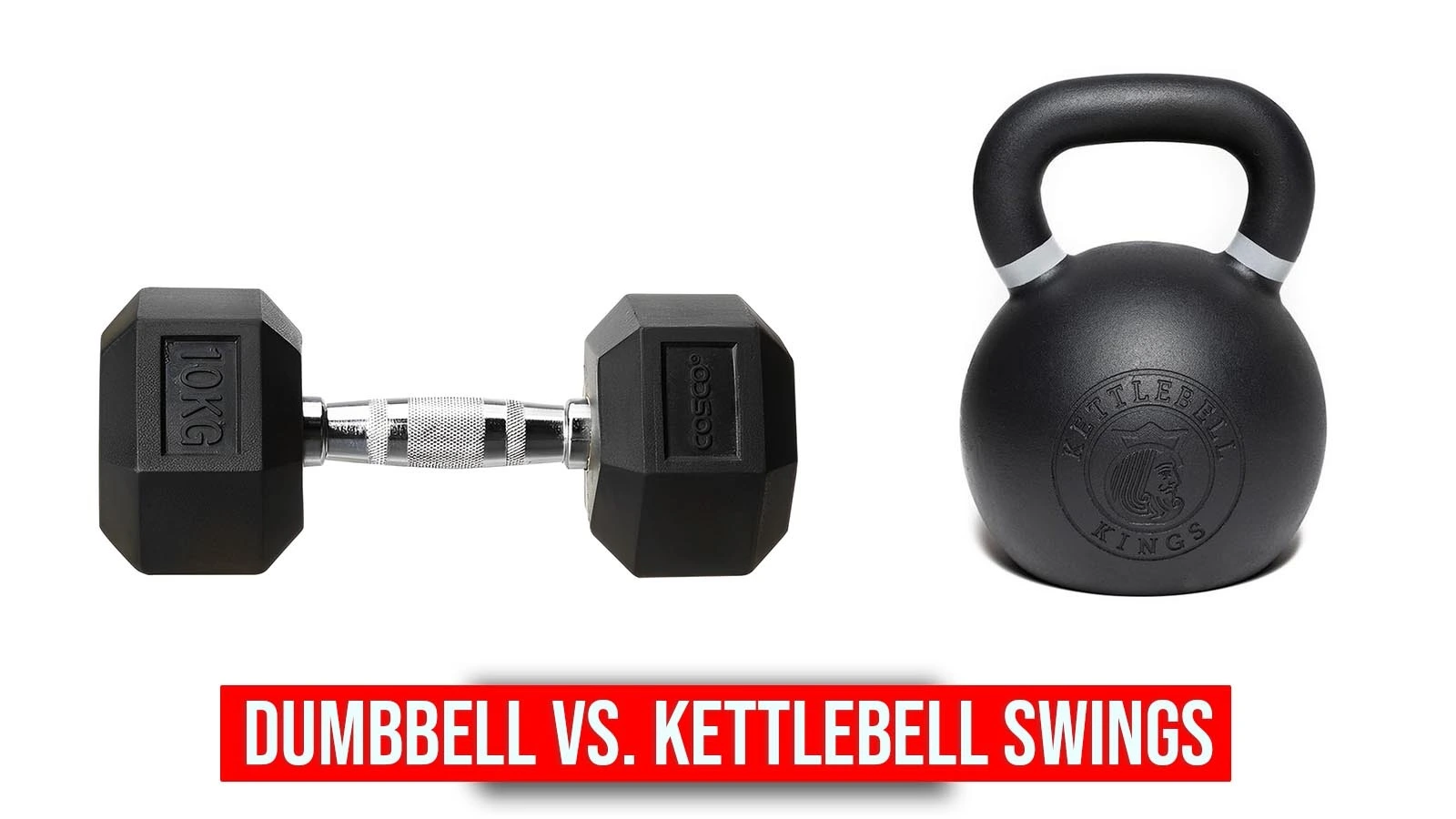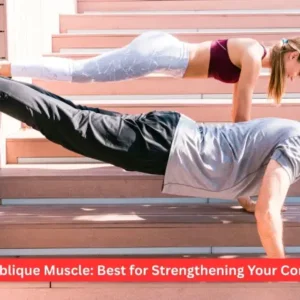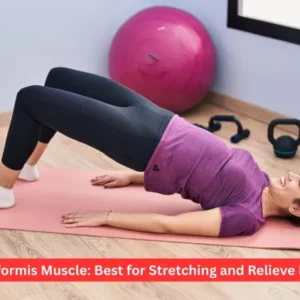If you’ve ever spent time in a gym or consuming fitness information online, there’s a good chance you’ve witnessed people hitting kettlebells. These weights in the shape of cannonballs with handles are becoming incredibly popular for a reason: kettlebells help build strength, endurance, and power, all simultaneously.
What would happen if you didn’t have any kettlebells? What if you can use the dumbbell instead? A lot of home-based fitness enthusiasts, as well as gym-goers, have been in this situation.
The answer is simple: performing swing exercises using dumbbells is possible. But there are some essential differences between them that affect how you perform the exercise and the benefits you’ll reap.
This guide covers all about dumbbells and kettlebell swings to help you choose the best for your fitness goals.
- Understanding the Fundamentals
- Equipment Comparison
- Technique Differences
- Muscle Engagement Comparison
- Benefits of Kettlebell Swings
- Benefits of Dumbbell Swings
- Which is More Effective?
- Who Should Choose Kettlebell Swings?
- Who Should Choose Dumbbell Swings?
- Program Recommendations
- Conclusion: Dumbbell vs. Kettlebell Swings
- FAQs
Understanding the Fundamentals
What is a Kettlebell Swing?
In this energetic exercise, you swing the kettlebell with your legs and raise it to eye or chest level with your hips. The exercise begins with an incline squat, and the strength comes from your hips extending upwards, not from your arms extending upwards.
What is a Dumbbell Swing?
The design of a dumbbell swing replicates this exact pattern, but it uses the dumbbell instead. Depending on your method of holding the dumbbell, the swing could differ from a kettlebell swing. However, the fundamental elements are the same: the hip hinge, explosive hip extension, and controlled deceleration.
Common Goals of Swing Exercises
Both exercises seek to:
- Develop strength in the posterior chain (back glutes, back and the hamstrings)
- Create explosive power
- Improve your cardiovascular fitness
- Burn calories efficiently
- Increase the performance of athletes
Equipment Comparison
Kettlebell Design and Weight Distribution
Kettlebells are unique in style—a solid ball with a handle at the top. This results in an off-center point, lower than your hands when you grip it. This design features:
- Let the weight move away from your body as you swing it
- This creates momentum, which challenges your stability
- This allows for a more fluid swinging motion
Dumbbell Design and Weight Distribution
Dumbbells, in contrast, are made of:
- A well-balanced weight distribution, with you putting the centre of gravity at the point of your grip
- A handle with a shorter length that’s made for a unique grip
- A less natural swing mechanic because of their shape
How These Differences Affect the Swing Motion
The kettlebell’s design allows it to move much more quickly in arcs. However, the dumbbell prefers to move in straight lines. This is why:
- Kettlebell swings are more natural and fluid.
- The dumbbell swing requires greater control and grip adjustments.
- The path taken by the weight is different as it moves through space.
Technique Differences
Proper Kettlebell Swing Form
- Keep your feet wide enough to be shoulder-width apart
- Place the kettlebell between your hands, facing you.
- Engage your hips (not a squat) to move that kettlebell in between the legs
- In a rapid, explosive way, push your hips forward, allowing you to lift the weight upwards.
- Let the kettlebell rise to eye or chest level naturally.
- Be aware of the descent as your weight shifts back and forth between your legs
- Reverse the hinge of your hip and thrust
How to Modify the Technique for Dumbbells
If you are using a dumbbell, you can choose between two grip choices:
End Grip (Recommended):
- Place an end of the dumbbell using two palms (the end plate)
- Let the weight fall in a vertical direction.
- Make the swing just the same way as you would with kettlebells.
- This grip is the most akin to kettlebell mechanics.
Standard Grip:
- Place the dumbbell horizontally on the handle.
- Your palms should be facing each other.
- The motion is the same; however, the path for weight is distinct.
- The focus should be on limiting the rotation of dumbbells.
Common Mistakes to Avoid
With kettlebells:
- Utilizing arm muscles instead of hip strength
- There should be more squatting, Instead of bending
- Let your back turn
- The swing is too high (above the shoulder level)
With dumbbells:
- The dumbbell is slipping off the bar.
- Uneven distribution of weight results in twisting
- The dumbbell is hitting your legs with a shivering force.
- Moving to a front raise instead of a swing
Muscle Engagement Comparison
Primary Muscles Worked in Kettlebell Swings
- The glutes (buttocks) are the primary power source.
- Hamstrings (back of the thighs)
- The muscles of the lower back (erector spinae)
- The core muscles (for stability)
- Upper back and shoulders (for control)
Primary Muscles Worked in Dumbbell Swings
The dumbbell swings target the same muscles, but there are some variations:
- Potentially higher grip engagement and forearm because of the awkward grip
- Occasionally, there is more shoulder involvement because of the straight line of motion.
- There is a similar activation of the posterior chain, but with slightly different mechanics.
Differences in Secondary Muscle Engagement
The variation in the distribution of weight is a sign of
- Kettlebells are a better choice to concentrate on the posterior chain in general.
- Dollybells may activate stabilizing muscles to manage the weight.
- Using dumbbells emphasizes the development of grip strength. This is especially the case when you’re using the end grip.
Benefits of Kettlebell Swings
Cardiovascular Benefits
Kettlebells can raise your heart rate quickly and maintain it at a high level. This makes them excellent for:
- Improved endurance of the heart
- The ability to burn calories efficiently
- Create an “afterburn effect” where you continue to burn calories after exercising.
Strength and Power Development
The high intensity of kettlebells is a great help in:
- Develop muscle fibres that are fast-twitch (important in power)
- Develop hip strength that can be transferred to other activities.
- Increase overall strength endurance.
Posterior Chain Development
A few exercises focus on all posterior chains as well as kettlebell swings.
- They build those “pulling” muscles often neglected in daily life.
- Assist in preventing forward-leaning postures caused by sitting.
- Strengthen your functional capacity for everyday routine.
Grip Strength Improvement
The kettlebell handle tests your grip in an original method:
- The handle’s thickness increases the forearm’s strength.
- The swinging motion tests your grip’s endurance.
- This can translate into more excellent performance on other lifts and sports.
Benefits of Dumbbell Swings
Accessibility and Convenience
The most significant benefit of swinging dumbbells is their accessibility:
- Many people have dumbbells already at home.
- Each gym is equipped with dumbbells. However, not all gyms have kettlebells.
- Start with lighter weights and move on more quickly.
Equipment Versatility
The dumbbells are versatile and offer features that kettlebells can’t compete with:
- Utilize the same equipment to complete your entire training.
- It is easy to adjust your weight by switching dumbbells.
- Perform single-arm modifications more effortlessly.
Potentially Safer for Beginners
Some beginners find dumbbells less intimidating:
- The grip that you have used before might feel more secure.
- There is a lower chance of incorrect technique that causes the weight to push you off your balance.
- Start with light weights and move to heavier ones more easily.
Modified Range of Motion Advantages
The different centers of gravity could be beneficial:
- Such an approach could provide a more effortless learning experience.
- Taller people find it easier to prevent the weight from striking the ground.
- Less momentum means more muscle control is needed.
Which is More Effective?
Research Findings on Effectiveness
The research that explicitly compares kettlebells to dumbbell swings is not extensive, but it does reveal:
- Research has shown that kettlebell swings are highly effective in the development of power.
- A unique and incredible weight distribution for kettlebells gives certain advantages for training.
- Both tools are practical when utilized correctly.
Calorie Burn Comparison
In terms of calorie burning:
- Both are extremely effective.
- Kettlebell swings could be a little more effective due to their natural swinging mechanics.
- The correct form is more important than the implementation choice.
Strength Development Comparison
For building strength:
- Kettlebells are a great way to increase athletic power because of their ballistic nature
- Dumbbells are great for strength, provided that the proper form is maintained.
- The principles of progressive overload apply to both.
Functional Fitness Benefits
For everyday life applications:
- Both exercises develop functional movement patterns.
- Kettlebells may better simulate real-world lifting scenarios
- The strength of dumbbells is controlled and can be easily incorporated into daily activities.
Who Should Choose Kettlebell Swings?
Training Goals Best Suited for Kettlebell Swings
Kettlebell swings could be more effective when you’re trying to achieve:
- Maximum power development
- Training for specific sports (especially for combat soccer, football, etc.)
- Add dynamic movement to your routine
- Then, you can do other kettlebell exercises.
Physical Requirements and Considerations
Kettlebell swings could be a better option when:
- You’re in excellent hip mobility.
- Your grip strength has already built
- You’ve been through hip hinges.
- You’re comfortable with ballistic movements.
Workout Program Integration
Kettlebell swings are well integrated into the following:
- It is a great way to get HIIT (High-Intensity Interval Training) workouts
- Power development programs
- Minimal fitness routines
- Functional fitness programs
Who Should Choose Dumbbell Swings?
Training Goals Best Suited for Dumbbell Swings
You should think about swinging dumbbells for your purposes if they include:
- Improvement in general fitness
- The swing pattern to learn before purchasing kettlebells
- Offering a variety of dumbbell exercises
- Strengthening strength in grip and endurance
Physical Requirements and Considerations
Doing dumbbells is a good idea If:
- You’re new to fitness.
- There are concerns regarding the strength of your grip.
- The hip hinge is a new pattern.
- You would prefer greater control and less Adobe.
Workout Program Integration
Dumbbells are excellent for:
- Home workout programs that require only a small amount of equipment
- General exercise routines
- Supersets, in combination with other dumbbell exercises
- Progressing through learning progressions before advancing to kettlebells
Program Recommendations
Sample Workout Routines with Kettlebell Swings
Kettlebell Power Routine:
- Kettlebell swings: 5 sets of 10 reps
- Rest 60 seconds between sets.
- Concentrate on power that is explosive and not fatigue.
Kettlebell Conditioning Circuit:
- 30 seconds of kettlebell swings
- 30-second push-ups for 30 seconds
- 30 seconds of rest
- 30 seconds goblet squats—goblet
- 30 seconds for mountain climbers
- 30 seconds of rest
- Repeat the process 3-5 times.
Sample Workout Routines with Dumbbell Swings
Dumbbell Beginner Routine:
- Do dumbbell swings: Sets of 3 reps.
- Rest 90 seconds between sets.
- Be focused on form rather than speed.
Dumbbell Full Body Workout:
- The dumbbell swings 15 reps.
- dumbbell rows: 10 repetitions for each arm
- Dumbbell Squats: 12 reps
- Push press dumbbell 10 reps
- Rest for 60 seconds.
- Repeat 3 times.
How to Progress with Each Type of Swing
To increase the progression of kettlebells:
- Master Form with a more manageable weight.
- Volume increase (more sets/reps)
- Gain weight
- Reduce rest times.
- You can also add swing variations (one-handed double kettlebell).
For the progression of dumbbells:
- A perfect shape and lightweight weight
- More repetitions
- Gain weight
- Try various grip positions.
- Create the complexity (single-arm swings, alternate swings).
Conclusion: Dumbbell vs. Kettlebell Swings
Both dumbbell and kettlebell swings are excellent for fitness and offer many benefits. The choice you make should be based on:
- Equipment available: Use what you have access to.
- Your objectives: Power athletes might prefer kettlebells. Fitness fans may profit from any of them.
- Your experience level: Beginners can begin with dumbbells and then progress to kettlebells.
- Your personal preference: It’s best to choose an activity that you regularly engage in.
Be aware that correct posture is more important than any specific equipment you’re using. Learn the hip hinge pattern, concentrate on extending your hips explosively, and maintain control of your weight throughout the exercise.
If you decide to use kettlebells and dumbbells for your swing workout, they should appear in many workout routines because of their effectiveness and efficiency in creating real-world strength and power.
FAQs
Can I get the same workout with dumbbells as kettlebells?
Yes, doing an identical workout is possible, but they’re not the same. Kettlebells produce a more natural swing, whereas dumbbells require greater control and can work differently developed muscles.
Which is better for beginners?
Many beginners find dumbbells less intimidating, especially when beginning to learn the hip hinge pattern. But light kettlebells can be excellent learning tools if they are available.
Do I need special dumbbells for swings?
No, regular dumbbells work fine. Hexagonal dumbbells might be more comfortable for the final grip method than round ones.
How heavy should I start with?
Men new to the sport could begin with a 10 to 15-pound dumbbell or a 16-kg kettlebell, and women could start with a 5- to 10-pound dumbbell or an 8-kg kettlebell. Always prioritize form over weight.
Can I do single-arm swings with dumbbells?
Yes, single-arm dumbbells are feasible and could be an excellent exercise after mastering the two-handed variation.
Will switching between kettlebells and dumbbells confuse my muscles?
The body will quickly adapt to any slight changes. Indeed, diversity is beneficial to continue growth and avoid plateaus.







